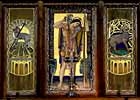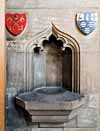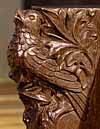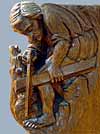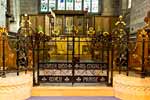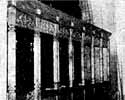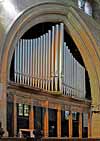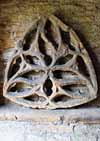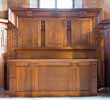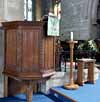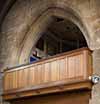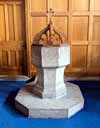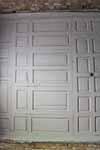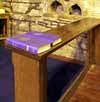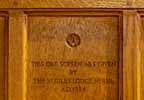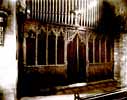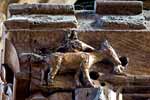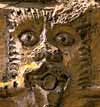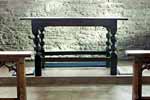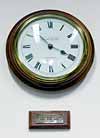For this church:    |
West Bridgford St GilesFeatures and FittingsChancel
High AltarThe oak altar in the chancel was presented by members of the church and the West Bridgford Branch of the British Legion. It was dedicated on Sunday, 14th June 1942 to the memory of the late Rector, Canon Hatfield, who was for many years President of the branch. A plaque on the south wall of the chancel, close to the altar, acknowledges:

Reredos behind High AltarThe reredos behind the high altar is of oak, carved with vines. On either side are angels clothed in priestly vestments, one holding an orb, and the other a crown of thorns, with the text Diligis me (do you love me). The centre picture of the reredos in the chancel is a painting of 'The Good Shepherd' by Edward Woore. A past rector, Canon Wilkinson, felt that the painting was not entirely in keeping with the ancient architecture of the church and so covered it with a picture of 'The Four Seasons'. In the left panel is a lamb and a cross on a hill; in the right is a ram caught in a thicket. The reredos was a gift, as recorded on a plaque discreetly mounted on its southern side which reads: 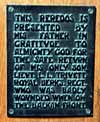
The father was Alderman Louis Oram Trivett, who had founded a plain net manufacturing business, which became one of the best known in Nottingham’s Lace Market. He had many interests but probably the chief one was the Boy Scout movement and he was a personal friend of Lord Baden Powell. Trivett played a major part in founding the West Bridgford troop and presented them with a Scouts’ Hut on Eltham Road. Many people called him ‘the Orchid King’ as his hobby was growing orchids and he was rarely seen without one in his button hole. His son, Louis Leslie Trivett, was born in 1897 and was just 18 years old when he became a temporary Second Lieutenant in the Worcestershire Regiment on 8th September 1915. He was transferred to the Royal Berkshire Regiment in January 1917 and was reported wounded in May of that year. He also became very involved in the local Scout movement and lived to the age of 78. A plaque on the south wall of the chancel records:

Shields 
Choir Stalls
The choir stalls have a number of delightful carvings. 
Clergy Seats
Each chair bears a plaque worded:

Ornamental Iron Screen

Choir Screen
The oak screen behind the choir stalls, separating them from the George Chapel, was given by the Flewitt family in 1948, together with the pulpit. The picture shows the screen immediately after its installation. The screen was made by Bowmans of Stamford. 
Triangular Window
The original medieval window is displayed in the church porch. George Chapel
George Chapel Altar and Reredos
At the front of the altar is carved 'Love one another even as I have loved you'. Nave
Pulpit 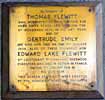
The previous pulpit, which had been in use since about 1870, was of somewhat mixed parentage. It had been created by turning the oak panels of its predecessor inside-out and carving them and then adding a base formed of the old sounding board and pillars made out of the old altar rails. This pulpit was repaired in 1886, with 'some excellent carving corresponding with that upon the choir screen', at a cost of £20. When eventually removed, the old pulpit was found to be in a precarious condition. Floods had induced rot into the wood and some of it had to be burned at once to avoid the risk of the fungus spreading. 
Lectern Around the base of the current lectern is written:

Balcony to Ringers' Gallery

Font
The font was moved under the tower during the church restoration in 1871. It was then moved into its current position as part of the work of installing the peal of bells in 1956. 
Mother & Child
The statue has the plaque on its base reading:

Collection Box
Painted on the front is 'Church Extension Weekly Voluntary Offerings'. 
Box Pews
South Aisle
Home Guard Old Comrades AssociationThe plaque reads: 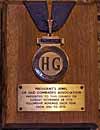
The jewel itself is inscribed: 'No 3 PLATOON 2ND NOTTS BATTALION HOME GUARD'. 
ShelfA plaque on the shelf below the window to the east of the porch records that the shelf is:

Vestibule ScreenThe vestibule screen, of Austrian oak, was the gift of local freemasons 'in commemoration of those brethren of the lodge who have been summoned to the Grand Lodge above'. It was dedicated at a service on 29th April 1934. Carved on the east side of the screen is a masonic symbol and these words: 
ShelfA plaque on the shelf below the window to the west of the porch records that the shelf is:
South Chapel
Rood Screen
The most notable feature in the church is the rood screen, which has moved backwards and forwards during its long life at St Giles' before settling at its present position forming the entrance to the south chapel. It has been described as having the character of a stone screen carried out in wood, with mason joints; stylistically it dates from the late 14th century. The screen has been much repaired during its life. The most authentic tracery ornament is that to the north, where a fox carrying its prey is carved. 
Elizabethan Communion Table
Clergy Vestry
|



